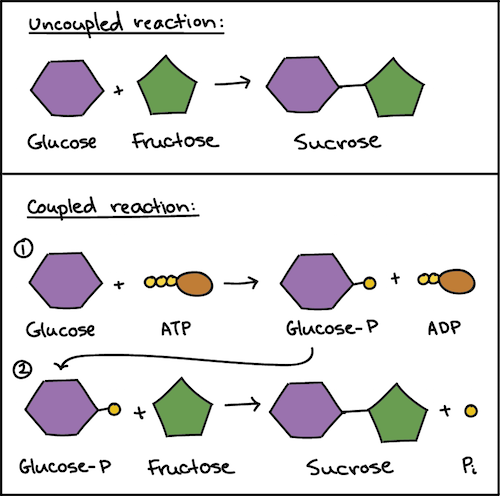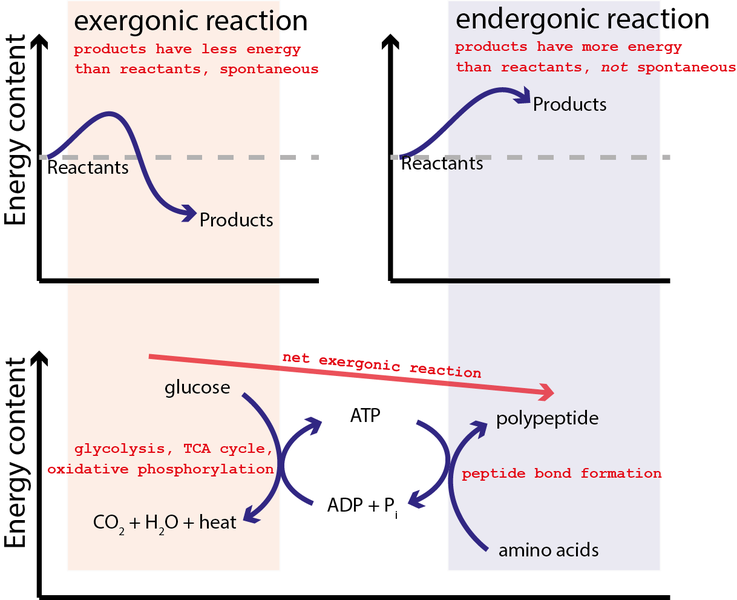Coupling Endergonic and Exergonic Reactions
The reaction is ENDERGONIC or in the case of heat endothermic. Biochemistry studies the chemical properties of important biological molecules like proteins and in particular the chemistry of enzyme-catalyzed reactions.

Atp Cycle And Reaction Coupling Energy Article Khan Academy
This kind of reaction is termed EXERGONIC or if it releases heat exothermic.

. This further underlines the unique character and orthogonality of the coupling reaction presented herein. The two reactions are coupled means -the energy provided by an exergonic reaction is either released Q. As such MS-PCET can function as a non-classical mechanism for homolytic.
The capability of microbial cells to live function and replicate in an appropriate chemical milieu such as a bacterial culture medium and the chemical changes. Cleavage of 3o bearing an indoline amide can easily be achieved through oxidative conversion to the. They also serve for energy coupling with endergonic reactions notably the formation of phosphoanhydride compounds.
However Huber and Wächtershäuser reported low 05 acetate yields based on the input of CH 3 SH methanethiol 8 mM in the presence of. Although several examples of coupling reactions between α-bromo- and α-iododifluoroacetamides with alkenes have recently been. The assembly of NaI and PPh 3 with the RAE N -cyclohexanecarbonylphthalimide to form a charge transfer complex CTC via coulombic interaction is calculated to be exergonic by 38 kcalmol Fig.
Give an example of each Irreversible and Reversible Reactions. MS-PCETs are redox mechanisms in which both an electron and a proton are exchanged together often in a concerted elementary step. The reaction is quite exergonic with a G of -43 kJmol -103 kcalmol.
KS1 and Rhodopseudomonas sp. Cells the most fundamental and vital unit of life are found in all living things. The reaction is quite endergonic with a G of 493 kJmol 118 kcalmol.
The addition of the 4-aminopyridine-boryl radical to 1a is exergonic to give a stabilized radical Int-2. The Regeneration of ATP ATP is a renewable resource that is regenerated by addition of a phosphate group to adenosine diphosphate ADP The energy to phosphorylate ADP comes from catabolic reactions in the cell The ATP cycle is a revolving door through. The biochemistry of cell metabolism and the endocrine system has been extensively described.
In the second reaction the formation of the bond between the carboxylic group at C-1 of 13-bisphosphoglycerate and orthophosphate occurs to form an anhydride called acyl phosphate. Hydrolysis can be used to drive an endergonic reaction Overall the coupled reactions are exergonic. Other areas of biochemistry include the genetic code DNA RNA protein synthesis cell membrane transport and signal.
The products lend themselves to rapid derivatization Scheme 2BC. The input of heat into an inherently endergonic reaction such as the elimination of cyclohexanol to cyclohexene can be seen as coupling an unfavourable reaction elimination to a favourable one burning of coal or other provision of heat such that the total entropy change of the universe is greater than or equal to zero making the total Gibbs free energy change of the coupled. LQ17 can oxidize nitrite anaerobically by coupling it directly to phototrophy 1149.
As reactions can be reversible if the forward reaction has a positive ΔG then the reverse reaction. If on the other hand ΔG is positive and you are looking up at the hill then the reaction is unfavourable or not spontaneous ie. Mannich reactions the desired β-amino amide 4 was not detected.
These respective exergonic energy-yielding and endergonic energy-requiring reactions are catalyzed within the living bacterial cell by integrated enzyme systems the end result being self-replication of the cell. Then SCS of Int-2 occurs through TS-II-1a with an energy barrier of 206 kcalmol which is found to be the rate-determining step. These activated acetic acid derivatives serve as starting materials for subsequent exergonic synthetic steps.
Aerobic oxidation of ammonia to hydroxylamine is an endergonic. We present here a review of the photochemical and electrochemical applications of multi-site proton-coupled electron transfer MS-PCET in organic synthesis. The calculations also suggested that complexation of NaI and PPh 3 is exergonic in acetonitrile through the cation-π interaction exergonic by 46 kcalmol.
CONCEPT 83âATP powers cellular work by coupling exergonic reactions to endergonic reactionsâ CONCEPT 84âEnzymes speed up metabolic reactions by lowering energy barriersâ CONCEPT 85âRegulation of enzyme activity helps control metabolismâ.

What Atp Is And Why It S Important In Metabolism Molecules Chemistry Metabolism

Endergonic And Exergonic Reactions Feedback Inhibition Youtube


0 Response to "Coupling Endergonic and Exergonic Reactions"
Post a Comment